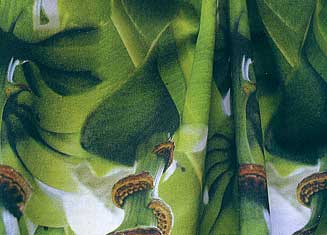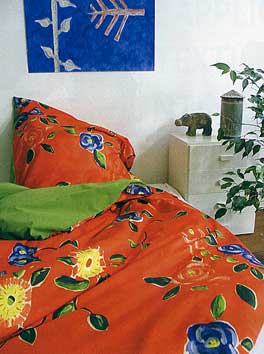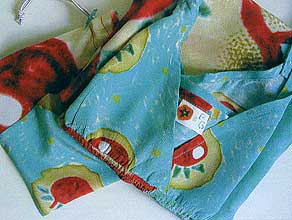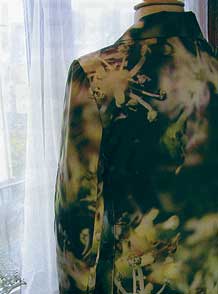Two
companies, Mimikry Digital Druck and Graffity Siebdruck are involved in
textile digital-printing. Read more about their activities and experiences.
 |
Direct
digital-print on cotton, based on close-up pictures from a banana
palm tree, 2004 |
About eight years ago, printers were not very wide (up to 90 cm), they were slow (about 1 m per hour) and did not have a feeding system for flexible substrates, so it was only possible to print fabrics pasted onto paper rolls. Printers with bubble-jet heads, that use heat to create the drops for printing, have been slowly replaced by piezo printers that allow the use of a larger variety of dyestuffs and pigments. Today, it is possible to find many different types of specialised textile-printers and even whole textile-printing systems that include software, dyes, pre-press and finishing processes. Unfortunately these are very expensive ones.
I would like to present two examples of companies that took the risk and now work with Digital Print. They are in the area where I live and I sometimes create my fabrics there.
Mimikry Digital Druck (Digital Print), Stuttgart, Germany
This company, established by two hardworking women, has worked for about six years exclusively with direct digital-print on natural fabrics. The idea of creating this company was born from a job that one of them had, involving digital-print expertise in a software development company.
<<
She became familiar with the printing process that was being developed. Together with another textile designer, they decided to venture out and start a small business creating a sort of textile copy-shop, fearing that in a couple of years a lot of similar stores would start competing against them.
Fortunately, the idea turned out to be so original and specialised that it is almost impossible to find another company in the area that works in the same way that they do, not only because they print on natural fibres, but also because they print small quantities.
The physical printing process they use does not differ much from the normal printing process on paper, apart from the following. The printer they use – a 1.40 m-wide bubble-jet printer – has been implemented with a special feeding system that allows them to print directly onto fabrics that are not pasted on paper. It uses reactive and acid dyes specially developed for this purpose, instead of normal ink.
The chemical process differs little from the one used in the textile industry for direct textile-printing on natural fibres. For Digital Print, all the chemicals needed to fix the dyestuffs to the fabric, such as sodium carbonate, urea and even an anti-fusant that prevents the colours from bleeding, are added to the fabric before the printing process, using a padding system. After it has been printed, the fabric has to be steamed and washed rigorously to eliminate the unfixed colour, producing a bright and washable fabric.
The biggest advantage of this complicated process is the possibility of printing on natural fibres without influencing their physical qualities. The fabrics created with this process can be used perfectly for garments and decoration.
>>

 |
Direct
digital-print on cotton, original design drawn with acrylic on paper
made especially for bed linen, 2004 |
 |
Direct
digital-print on silk. Drawing made directly on the computer. Dress
and package, 2004 |
Graffiti Siebdruck (Silkscreen printing), Reutlingen, Germany
About two years ago, Graffiti added a digital print system for transfer on fabrics to their silkscreen printing services. In this way they could offer giant impressions on flexible substrates that were both water- and light-resistant, to be used outdoors for publicity. The idea began with some jobs done together with a transfer-printing company that produced fabrics for decoration and sports clothing. That company had a Digital Print system to create strike-offs and colour samples.
The technique used is very simple. The designs are first printed on paper using sublimate dyes; afterwards, the paper decorated in this way is run together with the fabric through a calendar, where, with the help of heat and pressure, the colours are transferred from the paper to the fabric. This process, only possible using sublimable inks and polyester fabrics, can also be applied to many other objects made of synthetic materials.
The fabrics produced in this form can be used for garments and decoration, with the advantages and disadvantages of synthetic fibres.
<<
This method, and the new possibility of printing fabrics for garments, brought Graffiti new clients from the fashion business, some of whom started asking for transfer tests and ended up buying digital-printing systems themselves. It is not possible to disclose their names here, but if you look closely in a fashion store nearby, you probably could recognise their digitised creations. Also, Digital Print is still a big secret, but are we going to be able to stop the inevitable?
Compared to the traditional printing process, Digital Print is less contaminating because it does not require the use of screens and uses less water and chemicals. It allows production of small quantities, which makes it optimal for the production of exclusive collections. Unfortunately, the cost of these fabrics is still very high due to various reasons. It is only a matter of time before the textile market will be saturated with them. The question is, are we prepared for that?
For more information take a look at www.mimikry.com and www.graffiti-siebdruck.de
Published at "Eurostitch", 02.2005.
 |
Transfer
digital-print on polyester using close-up photos from flowers, 2003 |